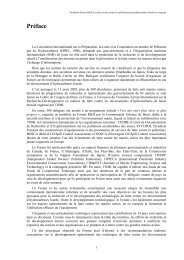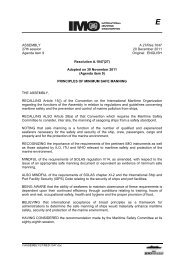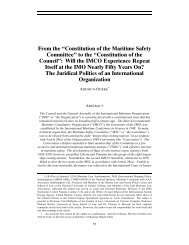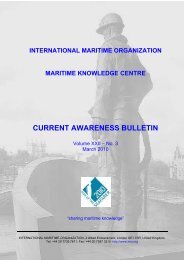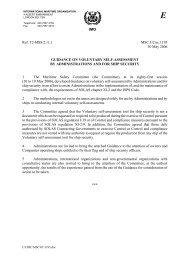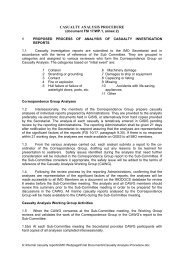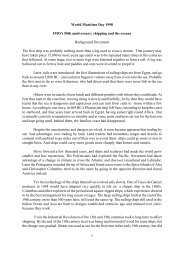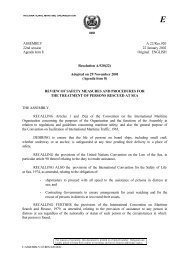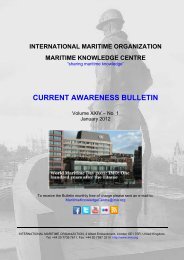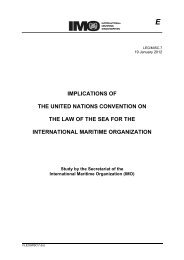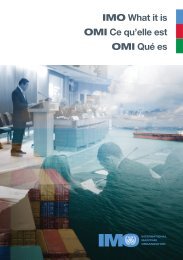Radioactive Waste Disposal at Sea: Public Ideas ... - IMO
Radioactive Waste Disposal at Sea: Public Ideas ... - IMO
Radioactive Waste Disposal at Sea: Public Ideas ... - IMO
Create successful ePaper yourself
Turn your PDF publications into a flip-book with our unique Google optimized e-Paper software.
Changing the Global Ocean Dumping Regime 149<br />
The 1993 Radwaste <strong>Disposal</strong> Ban: Emphasis on Precautions<br />
In the l<strong>at</strong>e 1980s, Greenpeace, Scandinavian and certain Northern<br />
European countries, and a few marine scientists successfully advoc<strong>at</strong>ed the<br />
precautionary principle <strong>at</strong> the scientific working group meetings of the<br />
global ocean dumping regime. 70 They succeeded in changing the underlying<br />
principles and norms of the regime as well as the scientific basis of regul<strong>at</strong>ion,<br />
with significant consequences for the radwaste disposal issue.<br />
According to the precautionary principle, unanimously adopted by the<br />
1991 annual London Convention meeting, “preventive measures are taken<br />
when there is reason to believe th<strong>at</strong> substances or energy introduced in the<br />
marine environment are likely to cause harm even when there is no conclusive<br />
evidence to prove a causal rel<strong>at</strong>ion between inputs and their effects”<br />
(LDC 1991, Annex 2). Equally significant, the concept of the assimil<strong>at</strong>ive<br />
capacity was rejected as the scientific principle underlying ocean dumping<br />
regul<strong>at</strong>ion, and countries agreed th<strong>at</strong> “existing pollution control<br />
approaches . . . have been strengthened by shifting the emphasis from a system<br />
of controlled dumping based on assumptions of the assimil<strong>at</strong>ive capacity<br />
of the oceans, to approaches based on precaution and prevention”<br />
(ibid.). By this decision, governments shifted the emphasis from “dispose<br />
and dilute” approaches to “isol<strong>at</strong>e and contain”approaches. Countries had<br />
earlier often been deadlocked because some, especially Britain, traditionally<br />
preferred regul<strong>at</strong>ion based on the assimil<strong>at</strong>ive capacity of the oceans,<br />
while others followed a more cautious approach. 71 Also the scientific deb<strong>at</strong>e<br />
on the radwaste disposal issue to a significant degree revolved around the<br />
concept of the assimil<strong>at</strong>ive capacity. 72<br />
In July of 1993, IGPRAD finalized its work. The final report listed seven<br />
policy options, but IGPRAD did not recommend any in particular as this<br />
would have been outside the terms of reference for its work. However, the<br />
report noted “the growing awareness within the n<strong>at</strong>ional and intern<strong>at</strong>ional<br />
communities th<strong>at</strong> new and more effective measures are needed to protect<br />
the global marine environment” (LC/IGPRAD 1993, Annex 2, p. 50). At<br />
the legal level, during the past 20 years “a trend towards, first, restricting<br />
and controlling, second, prohibiting sea disposal of radioactive wastes on<br />
a regional basis” was acknowledged in the report (ibid.). In regard to the<br />
scientific and technical issues, it was noted th<strong>at</strong> ocean disposal, in comparison<br />
with other disposal altern<strong>at</strong>ives for radioactive waste, could result in




